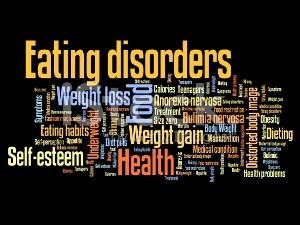Traditionally linked with old age, eating disorders are common among teenagers. Eating Disorders can severely affect teenagers and older children .It is an illness that leads people to  overeat, starve themselves or adopt other unhealthy behaviors surrounding food and their body image. Children these days are very conscious about their looks, and are somewhat obsessed with having the perfect body shape. This sometimes leads them to make such changes to their eating habits and this can interfere with their daily life and can if left untreated can cause serious health and psychological issues.
overeat, starve themselves or adopt other unhealthy behaviors surrounding food and their body image. Children these days are very conscious about their looks, and are somewhat obsessed with having the perfect body shape. This sometimes leads them to make such changes to their eating habits and this can interfere with their daily life and can if left untreated can cause serious health and psychological issues.
10 facts about eating disorders that you should know as a parent, guardian, or a teenager
Eating Disorder is becoming an Epidemic
Eating disorders are very prominent in teenagers, especially girls, who are more conscious of their looks. As per a research conducted in the USA, more than half of teenage girls and more than one third of teenage boys suffer from eating disorders.
Eating Disorders are directly related to their self-esteem
Eating disorders in teenagers are connected with emotional ill-being. Usually they develop eating disorders when they are undergoing an emotionally difficult time. They are much more likely to binge eat when they are undergoing stress, anxiety, or facing any other psychological problems. Their self-esteem is also hurt by strained family relationship, subjection to constant criticism from parents about body fat or eating habits, genetics, and sports eligibility, due to which later on they develop eating disorders.
Bullying is the major cause of Eating Disorders
Teenagers are very exposed to and affected by bullying, especially by their peers. Being bullied by their peers for being overweight terribly hurts their self-esteem, and puts them at a high risk of developing an eating disorder.
The unreasonable and factitious standards built around body figure by media also strengthen this bullying.
4.There’s not just one type of eating disorder
Most people are aware of only Binge eating as an eating disorder. But there are more. Other than Binge eating, Anorexia and Bulimia are the other two prominent eating disorders.
In Anorexia, people may stop eating certain foods or entire food types, mostly due to a fear of gaining weight. They may have Anorexia even if they are underweight in reality but still think they are overweight, and it tends to affect teenagers the most. In Bulimia, people tend to binge eat. The binge eating is always followed by purging, i.e. somehow taking the food out of the body. They may vomit, use enemas or laxatives, to take out the food that they just ate. Teenagers who have Binge eating disorder also tend to binge eat but it is not followed by purging, although most binge eaters feel guilty afterwards.
5.The Symptoms for Eating Disorders look very casual
People who have eating disorders usually try to hide the fact that anything is abnormal, or that they are suffering. Therefore it can be a little difficult to know when someone is having an eating disorder, but the behaviors and conditions that often imply eating disorders can be easily observed by family members and close friends, such as: intensively dieting even when they are underweight, constant obsession with weight, weakness due to improper intake of food, binge eating, absence of menstrual cycle (in female) in absence of other reasons, hair loss, compulsively exercising even when the circumstances do not permit so, among others. These are all very common symptoms that can imply a lot of other problems too; therefore professional medical advice must be sought.
6.Eating Disorders can severely affect health
Initially eating disorders may not seem to be a big deal, but if left untreated for a long time they may lead to havoc results. Being underweight or overweight, weak bones that severely increase the risk of fracture, kidney and heart diseases are the most common repercussions of eating disorders. Eating disorders are also often accompanied by other psychiatric issues such as anxiety disorders, depression, and sometimes even substance abuse (smoking, alcohol, and drugs).
Intervention is necessary for eating disorders. The symptoms of eating disorders can be observed by people close to the person, and a professional therapist can be contacted for a medical analysis to determine whether it is an eating disorder or not and its treatment. Intervention in initial days can prevent further problems that may arise as a result of it.

